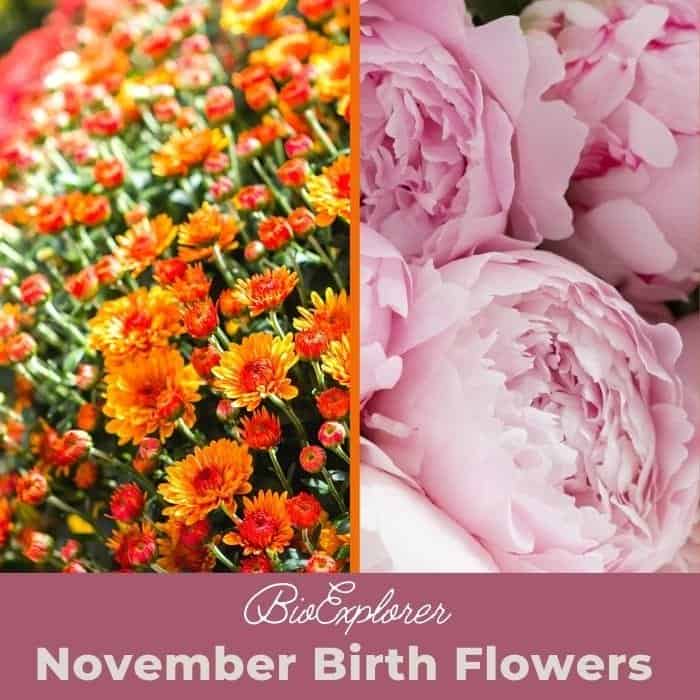
Birth Flowers have been a tradition for hundreds of years. Each month has flowers associated with it that represent that time of year. The custom of birth flowers originated as far back as the ancient Romans, who associated flowers with their gods and goddesses.
Over time, different cultures and customs assigned various flowers each month and the people born during those months. The Victorian era especially emphasized the symbolism of flowers regarding birth months.
November has two official birth flowers associated with it:
- The chrysanthemum
- The Peony
These two blooms have unique characteristics and a rich history that make them fitting representations for the month of November. Their vibrant colors and full, ruffled petals give them a stand-out beauty.
chrysanthemums and peonies also carry deep meaning. Their symbolism speaks to the introspective, spiritual nature associated with late autumn.
Key Takeaways:
- Birth flowers have been a tradition for centuries and carry symbolic meaning.
- Each month has particular flowers associated with it.
- November’s two birth flowers are the chrysanthemum and peony.
- These blooms have distinctive beauty, history, and significance.
This article will explore the captivating history, meaning, and significance behind the November birth flowers. Knowing the language and lore of these blooms provides a new appreciation for their role as messengers in the natural world.
Table of Contents
- The Chrysanthemum November Birth Flower
- Caring for Chrysanthemums
- Symbolic Meaning of Chrysanthemums
- The Peony November Birth Flower
- Caring for Peonies
- Symbolic Meaning of Peonies
- Gifting and Enjoying November Birth Flowers
- November Birth Flowers in Art and Literature
- Fun Facts About November Birth Flowers
- Conclusion
The Chrysanthemum November Birth Flower
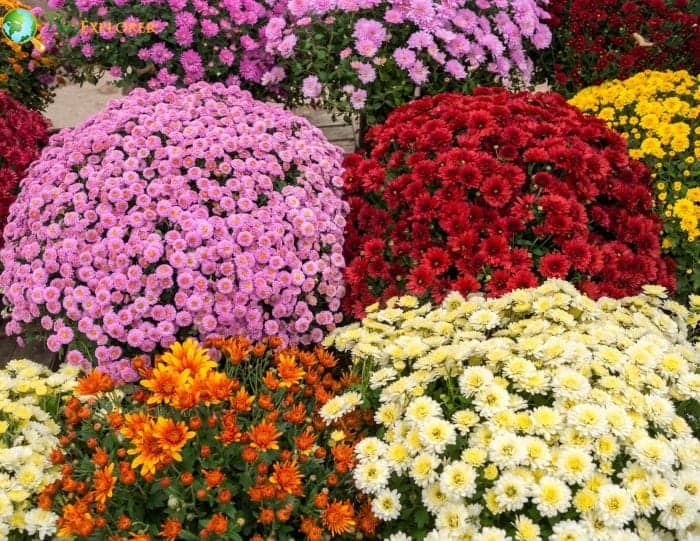
The chrysanthemum, commonly called the “mum”, is a vibrant, bold flower that blooms in various colors like red, orange, pink, purple, and yellow. This perennial plant grows best in cool climates and fully blooms in the fall.
Some key facts about the chrysanthemum:
- Originated in China over 2, 500 years ago. The name comes from the Greek words “chrysos” meaning gold, and “anthemon” meaning flower.
- In some countries, the chrysanthemum represents grief, lamentation, and death. In other cultures like Japan, it is seen as a symbol of longevity and happiness.
- Chrysanthemums have many medicinal uses. Chinese herbal medicine uses the flower to treat headaches, vertigo, and other ailments[1].
- In Japan, the Imperial Chrysanthemum seal is used as the official emblem of the Emperor. Different chrysanthemum blooms are associated with Japan’s royal family.
- Florist mums with densely layered petals are bred for ornamental purposes. The original Chinese chrysanthemum had more simple and sparse petals.
- In some countries, chrysanthemums are the November birth flower and the official Mother’s Day flower.
There are over 100 varieties of chrysanthemums. Some popular ones beyond the standard Daisy-like mum include:
- Spider mums: These have long, spindly, curved petals that look spider-like. Colors range from yellow to red.
- Pompon mums: These have very small, ball-shaped compact blooms. Popular as a potted plant for fall displays.
- Anemone mums: These have wider open centers and just one row of ray petals, giving a simple daisy shape.
Chrysanthemums speak the language of autumn abundance, good cheer, and connection to those who have passed on. Their history is rich, and there are countless varieties to appreciate.
Caring for Chrysanthemums
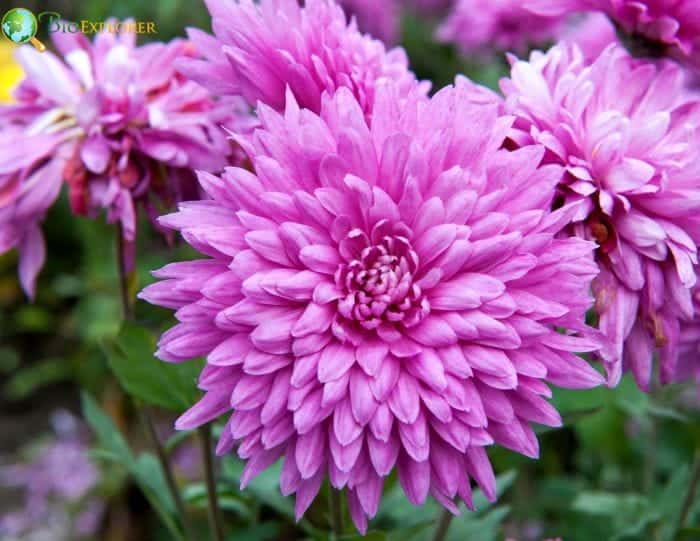
Chrysanthemums thrive when given proper care and conditions. Here are some tips for successfully growing vibrant, healthy chrysanthemums:
Planting and Growing Tips
- Chrysanthemums prefer full sun exposure for at least 5-6 hours daily. Part sun may cause leggy growth.
- Well-draining soil enriched with organic matter is ideal. Mums need good aeration and moisture retention.
- Start mums indoors 4-6 weeks before the last expected spring frost. Transplant seedlings or young plants into the garden after danger of frost.
- Pinch back growing tips frequently during the first few months to encourage bushy, compact growth. Discontinue pinching in mid-summer.
- Water mums 1-2 inches per week. Allow the soil surface to partly dry out between waterings. Too much moisture can cause root rot.
- Fertilize with a balanced liquid fertilizer every 2-3 weeks during the active growing season for vibrant blooms.
- Potted mums should be brought indoors in areas with cold winters before the first frost. Cut back watering for overwintered mums.
![]()
Combating Pests and Diseases
Chrysanthemums can sometimes be affected by certain pests and diseases:
- Aphids: These small, green insects suck plant sap. Apply insecticidal soap or neem oil.
- Thrips: Tiny black or yellow insects that feed on flowers. Can stunt plant growth. Use sticky traps and targeted insecticides.
- Gray mold (Botrytis): A fungal disease that causes spots, discoloration, and flower rotting. Improve air circulation and remove affected parts promptly.
- Septoria leaf spot: A fungus that creates brown spots on foliage. Spread by splashing water. Use fungicides and remove diseased leaves.
- Root rot from overwatering: Allow soil to dry out between waterings and improve drainage.
You can keep chrysanthemums healthy and vigorous by providing good growing conditions and monitoring for any issues. Proper care will be rewarded with an eye-catching display of November blooms.
![]()
Symbolic Meaning of Chrysanthemums
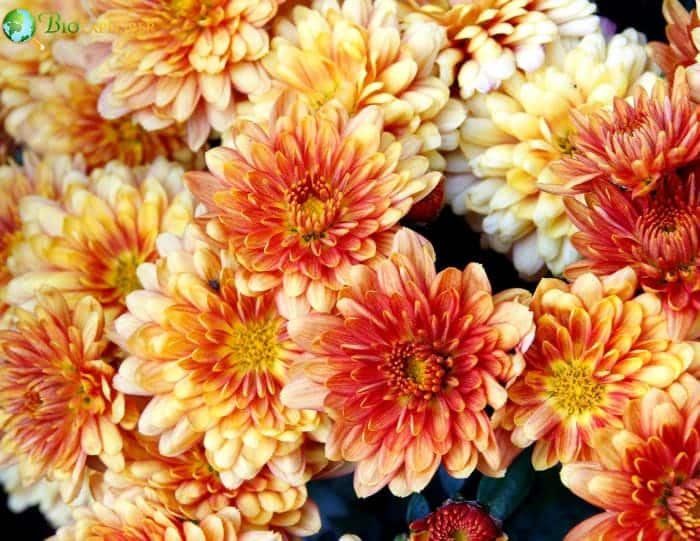
Beyond their physical beauty, chrysanthemums hold deep symbolic meaning in various cultures:
- In Japan, the chrysanthemum represents the royal family. The Imperial Seal of Japan features a 16-pedaled chrysanthemum bloom. Different bloom colors have meaning white for grief, yellow for celebration.
- In Chinese culture, chrysanthemums symbolize rejuvenation and longevity. Drinking chrysanthemum tea is believed to promote youthfulness and vigor.
- In the United States, the chrysanthemum is the official flower for Mother’s Day. Its symbolism includes love, fidelity, optimism, and joy.
- In Europe, chrysanthemums represent death and grief. Their tombstone-like mounded blooms are common in memorial flower arrangements.
- In the Victorian language of flowers[2], the chrysanthemum had numerous meanings depending on color white for truth, yellow for slighted love, red for “I love you“.
- In Japan and other Buddhist regions, chrysanthemums honor the dead during funeral services and burial rituals. Fresh-cut blooms are placed on graves.
So while the chrysanthemum conveys happiness in some cultures, its meaning shifts towards the solemn in other areas. But in all cases, the mum connects us to the ephemeral nature of life itself.
The Peony November Birth Flower
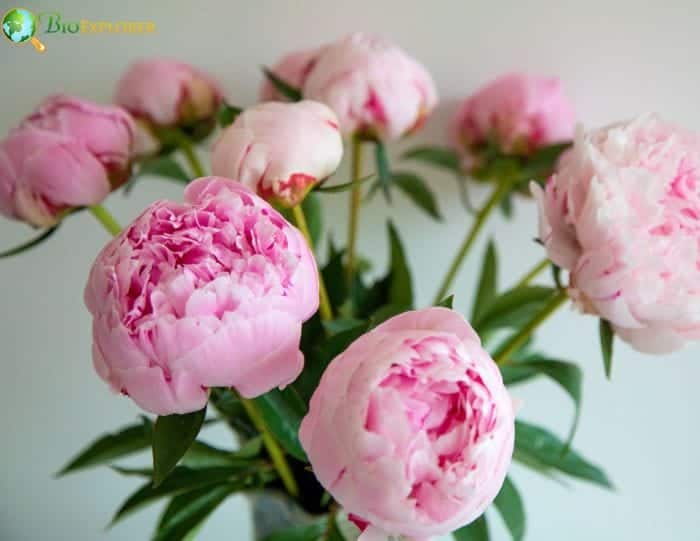
The peony is the second official birth flower for the month of November. These lush, full blooms grow on compact bushy perennial plants that can reach 3-4 feet.
Some interesting facts about peonies:
- Peonies are native to Asia, Europe, and the Western United States. They have been grown in gardens for centuries.
- The name “peony” comes from Paeon, the Greek physician of the gods. According to legend, Paeon healed Pluto but was turned into a flower by Zeus.
- Peonies have ornate, multi-layered blooms in shades like white, pink, coral, burgundy, and yellow. The flowers can grow over 7 inches in diameter.
- Peonies tend to be fragrant, with a sweet, floral scent. Some varieties are more strongly scented than others.
- Peonies represent honor, prosperity, and bashfulness in the language of flowers. Their lush blooms were a popular subject in still-life paintings.
- Peonies are perennials that live long lives if properly cared for. Bushes over 50 years old are not uncommon.
There are three main types of peonies:
- Herbaceous: With bushy foliage that dies back each winter. Tend to be more cold-hardy.
- Tree: Have woody stems and branching. Keep their foliage through winter. Grow taller.
- Intersectional: A hybrid cross between tree and herbaceous varieties. Have attributes of both.
With their lush, multi-layered blooms, peonies perfectly capture the abundant beauty of early summer. Their history is rich in myth and meaning.
Caring for Peonies
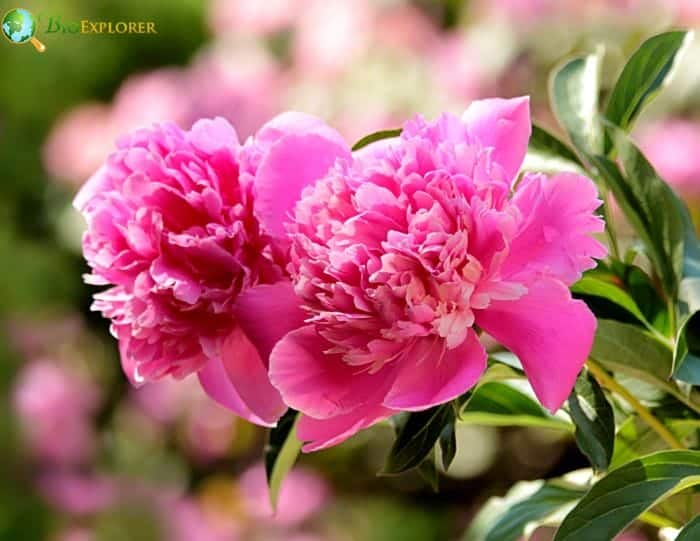
Peonies thrive when given proper growing conditions and care. Here are some tips for success:
Planting and Growing Tips
- Peonies prefer full sun, at least 6 hours per day. Morning sun is best as it dries dew from the foliage.
- Well-drained, nutrient-rich soil is ideal. Amend soil with compost or manure before planting.
- Plant peony roots 2-3 feet apart in early fall. Place the crowns just 1-2 inches below the soil surface.
- Water peonies regularly and during bud formation the first year after planting to establish the roots.
- Apply a balanced fertilizer or bone meal in early spring to fuel the coming season’s growth.
- Cut back dead foliage in fall, leaving at least 1-2 inches above ground. Insulate roots in very cold climates.
![]()
Pruning and Care
- Deadhead spent blooms during the flowering season to encourage more blooms. Cut just above a leaf axil.
- Remove weak, diseased, or excessive stems at ground level after flowering to improve air circulation.
- Cut herbaceous peonies down to the ground in fall once the foliage dies back. Tree peonies need minor branch pruning.
- Support floppy blooms by placing a ring of chicken wire or peony hoops around the plant before it blooms.
- Avoid transplanting established peonies. If dividing them, replant divisions promptly at the proper depth.
With attentive care focused on their needs, peonies will continue flowering for decades and may even outlive their gardeners!
![]()
Symbolic Meaning of Peonies
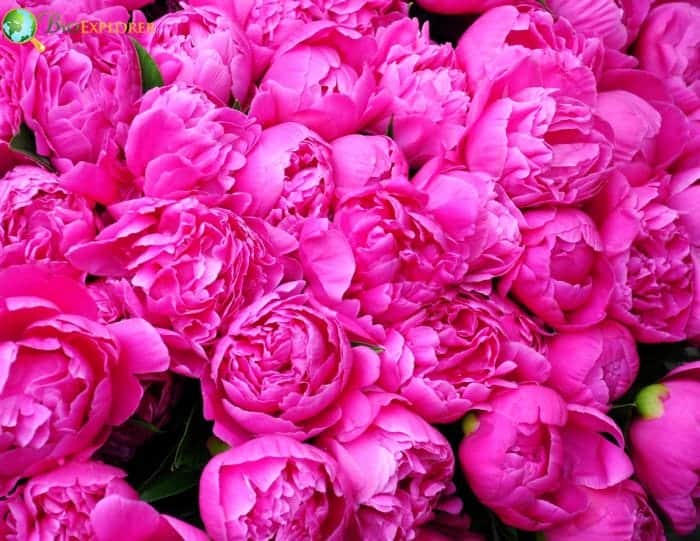
In addition to their outstanding floral display, peonies hold symbolic significance in cultures worldwide:
- In China, peonies represent honor, prosperity, and a happy marriage. Peony blooms appear frequently in Chinese art as an auspicious symbol.
- In Greek mythology, peonies are said to have been named after Paeon, a physician who healed the wounds of gods and men.
- During the Victorian era, peonies were said to symbolize bashfulness and shame due to their tendency to “bow their heads” when in full bloom.
- In the language of flowers, peonies can represent: Healing, Honor, Prosperity, Romance and a happy marriage, Bashfulness and shame & Compassion.
- Peonies are a traditional floral symbol for the 12th wedding anniversaries due to their meaning of happy marriage.
- In Japan and other cultures, peonies symbolize bravery. According to legend, peony seeds give courage to the lion.
So, in addition to their captivating blooms, peonies have a rich symbolic legacy spanning history, myth, and culture. Their meaning touches on prosperity, healing, bravery, and romance.
Gifting and Enjoying November Birth Flowers
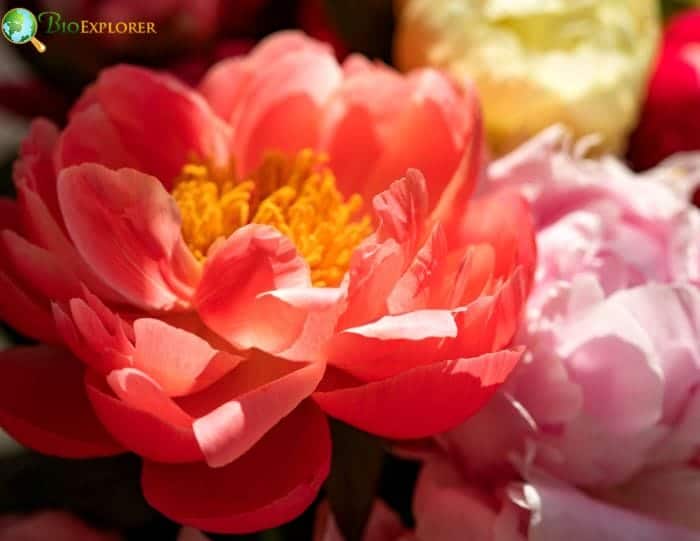
November birth flowers make for beautiful and meaningful gifts. Here are some ways to give and enjoy chrysanthemums and peonies:
- Purchase fresh-cut flowers from your local florist, flower market, or online retailers. Opt for fully opened blossoms that are just starting to show pollen.
- Present November birth flowers in a vase or arrangement along with foliage like ornamental kale and creeping Jenny for texture.
- Recut stems and change the water every 2-3 days for a longer life. Use floral preservatives and avoid putting arrangements in direct sunlight.
- Potted chrysanthemums and bare-root peonies make great gifts for gardeners. Add a bow or plant marker with the birth flower meaning.
- Preserve November birth flowers by pressing them in a heavy book or drying them upside down in a dark, well-ventilated area. Use them to create personalized cards or crafts.
- Frame high-quality images of chrysanthemums and peonies as wall art or table decor. Choose photos that reflect the personality of the November-born recipient.
- Gift experiences celebrating these flowers, like tickets to a fall mum festival, a peony garden tour, or a floral design workshop.
- Bake a chrysanthemum or peony-themed treat like sugar cookies decorated with flower colors and shapes. Include the significance behind their birth flower.
Giving November birth flowers is a thoughtful way to celebrate someone’s uniqueness while connecting them to these blooms’ rich heritage.
November Birth Flowers in Art and Literature
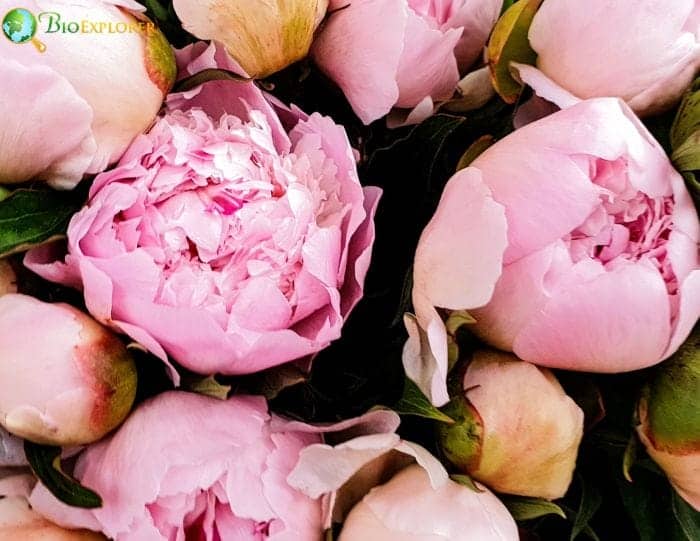
Chrysanthemums and peonies have inspired artists, poets, and writers for centuries. Here are some notable examples:
Art
- Vincent Van Gogh painted vivid still life paintings of chrysanthemums like ‘Vase with asters and Phlox’ displaying his signature bold brushstrokes.
- Georgia O’Keeffe created abstract paintings of enlarged peony blooms like ‘Pink Peony and White Larkspur No. 2’ emphasizing their curves and folds[3].
- Claude Monet captured peonies with soft, pastel tones in his Impressionist garden paintings, most famously his ‘Peony Garden’ series[4].
- Chinese brush painters like Yun Shouping created intricate peony artworks representing prosperity and honor in Han dynasty traditions[5].
- The 8th-century poet Du Fu wrote the Chrysanthemum Fu poem lamenting the passage of time and death[6].
Literature
- Peonies are symbolic in Alice Walker’s novel ‘The Color Purple’ representing growth and resilience[7].
- In Rhoda Lerman’s novel ‘The Book of the Night, ‘ peonies from a family garden connect generations of women.
- Ray Bradbury’s horror story ‘The October Game’ chillingly features chrysanthemums used in a twisted revenge plot[8].
From still life paintings to magical realism novels, November’s Birth Flowers continues to inspire creativity across the arts. Their rich symbolism and striking beauty give artists an infinite well of inspiration.
Fun Facts About November Birth Flowers
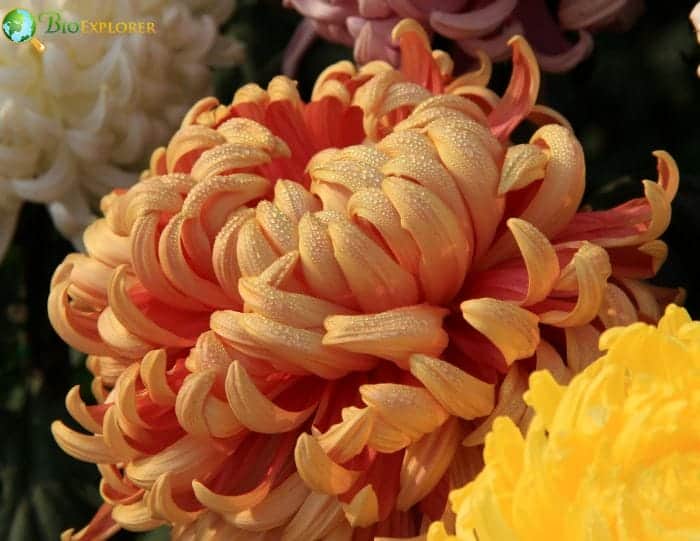
November’s birth flowers have some fascinating history and little-known tidbits behind them. Here are 10 fun facts about chrysanthemums and peonies:
- The chrysanthemum was first cultivated in China around 15th–10th century BC. Remains have been found in Chinese burials dating back to this time.
- Peonies grow wild across the Western hemisphere from Alaska to Mexico. Most originated as wildflowers before cultivation[9].
- Chrysanthemum blooms were used as a natural insecticide in ancient China, and the boiled roots made a headache remedy.
- Vincent Van Gogh painted over 20 paintings featuring chrysanthemums during his career; some of the famous ones are ‘Chrysanthemums and Wild Flowers in a Vase’ (1887), ‘Bowl with Chrysanthemums’ (1886) and ‘Vase with Poppies, cornflowers, Peonies and Chrysanthemums’ (1886).
- In Japan, over 5, 000 named varieties of peonies are cultivated for ornamental purposes[10].
- During the 1870s, peonies became so extensively collected in Europe that guards had to protect plants from theft[11].
- Peonies are the “flower of riches” in China, traditionally planted around homes to attract wealth[12].
- Football mums are a specific chrysanthemum variety bred to bloom in school football team colors.
- Chrysanthemum flowers can be used to make wine and tea, both believed to have health benefits in Chinese medicine.
- Peonies are named after Paeon, the physician of the gods in Greek mythology who healed wounds with peony root[13].
The long histories of these November blooms are filled with fascinating facts and lore! Their origins, medicinal uses, and collectors’ obsessions offer unique insights into these traditional fall flowers.
Conclusion
As the November birth flowers, chrysanthemums and peonies have distinct beauty and symbolism befitting the fall season. Their lush, abundant blooms in shades of gold, crimson, pink, and white reflect the final stages of the yearly growth cycle.
These November flowers carry deep cultural meaning around the world related to honor, devotion, grief, and remembrance. Their histories span centuries and continents, weaving into our myths, arts, and traditions.
Beyond their profound symbolism, chrysanthemums and peonies give us the gift of their spectacular visual presence – a reminder to embrace each fleeting moment of beauty whenever it unfolds. By learning the “language” of these November blooms, we stay connected to the cycles of nature and our own journeys.











